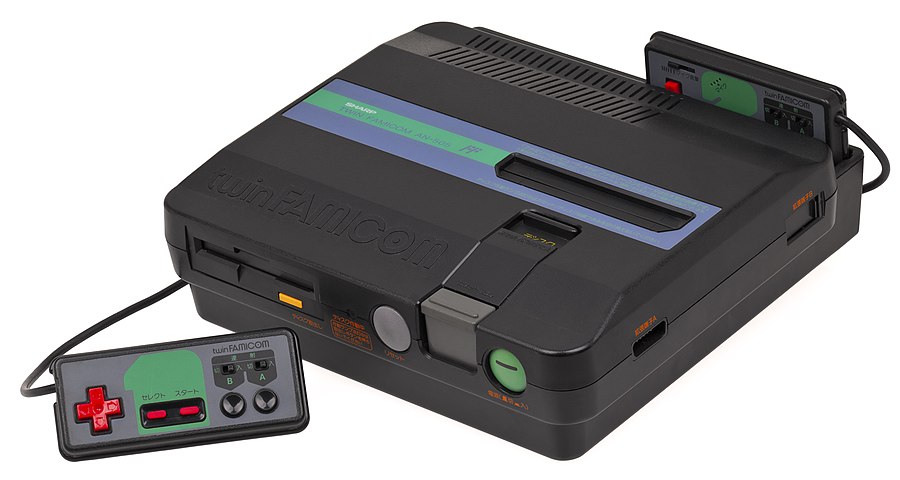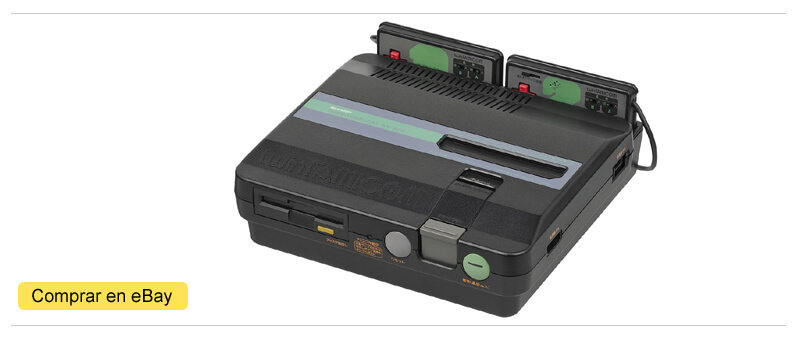Sharp’s Twin Famicom is the ultimate Famicom. Exclusive to Japan, Sharp combined Nintendo’s 8-bit console and its new peripheral, the Famicom Disk System, into a single machine, creating a console capable of playing the entire Famicom game catalog while also providing improved video quality. image.
Today the Twin Famicom has become a jewel for collectors of retro consoles and video games, given its uniqueness and the scarcity of consoles sold. Let’s remember what the Famicom manufactured by Sharp, the Twin Famicom, was and is like.
| COMPANY: | Sharp |
| GENERATION OF CONSOLES: | 3rd GENERATION OF CONSOLES |
| RELEASE DATE: | 1986 Japan |
| GAMES CATALOG: | 1,053 compatible cartridges (Japanese) + 198 Famicom Disk (+4 official not for sale) |
| SOLD UNITS: | Approximately 1 million |
| LAUNCH PRICE: | 32.000 yen |
| PROCESSOR: | 8-bit Ricoh based on MOS Technology 6502 at 1.79 MHz |
| FORMAT: | Cartridge and magnetic disk (Famicom Disk) |
| BUY IT ON EBAY: | https://ebay.us/6yoA9V |
- History of the Twin Famicom
- Price of a Twin Famicom console. How much?
- Collect the Twin Famicom.
- Buy a Twin Famicom.
- TOP Retro: Best games of the Twin Famicom.
- FAQ Twin Famicom.
- Technical characteristics of the Twin Famicom.
Twin Famicom, Sharp’s Famicom
Launched on July 1, 1986 in Japan for 32,000 yen, the Twin Famicom is one more of the Famicom licensed by Nintendo and manufactured by Sharp, this time a combo of the most successful console of the 80’s in Japan, with its star peripheral of those years, the Famicom Disk System, creating one of the most unique and exclusive consoles ever made: The perfect Famicom.
Twin Famicom Background: The Nintendo Famicom and the Famicom Disk System
Nintendo changed the world of video games in 1983 with the launch of its Famicom, a powerful but cheap 8-bit console, which, thanks to its new internal architecture, offered features never seen before in the world of consoles. The Famicom moved the epicenter of video games, taking it from the United States (fathers of video games) to Japan, to stay in the Japanese country for the following decades.
The Famicom was everything at the time, the most successful console of the 80’s, it came to absolutely dominate the video game market in Japan, while saving the business model of video game consoles in the rest in the world with his NES and his seal of quality. Nintendo set the course and led all the companies in the sector, becoming, on its own merits, the most important company in the history of video games.
The Famicom was a great success but it had a serious problem and disadvantage compared to the computers of the time: The price of the cartridges. Due to the high cost of memory, chips, and semiconductors in cartridges in the mid-1980s, a Famicom video game cost an average of 5,000 yen, much more expensive than floppy disks or tapes in computers at the time. Sellers and retailers themselves were asking Nintendo for an impossible price cut on their games, so Nintendo got to work.
Being already the queen of consoles, Nintendo saw the next rival to beat the computers of the time, which were tremendously expensive but could offer cheaper software thanks to the format of the discs. Inspired by its new competition, Nintendo saw the potential of rewritable discs as a format for its console and on February 21, 1986 Nintendo launched the Famicom Disk System for 15,000 yen, the perfect peripheral for the Famicom:
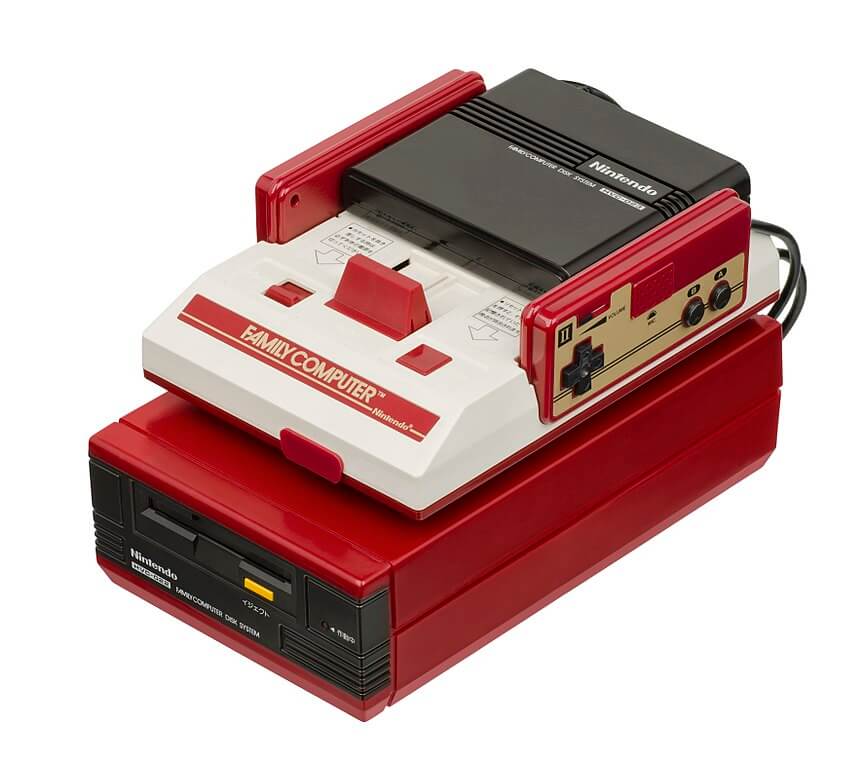
The FDD brought to the Famicom the new format of magnetic disks, the Famicom Disk, which had a capacity of 896 kilobits (112 kilobytes), with 64 kB per side, almost 1 MB, being really a format adapted from the Quick Disk standard of the company Mitsumi Electric. The benefits of the Famicom Disk as a format were numerous:
- Capacity: At the time of its launch, no cartridge had reached 1 MB.
- The Famicom Disk introduced the possibility of recording the game. At its launch the lithium battery had not yet been incorporated into the cartridges.
- The new games in the Famicom Disk format were much cheaper, from 5,000 yen to 3,000 yen.
- The Famicom Disk System could be rewritten for 500 yen, the cost of the blank disk was 2,000 yen.
- Developers had more freedom and could make larger games using multiple discs, something impossible to do with the cartridge.
The Famicom Disk System became a huge success, selling 4.5 million units over the next few years, not bad for a simple peripheral only released in Japan. Nintendo was able to recognize its weakness and offer a solution to its users, developers and distributors, launching the perfect peripheral in relation to its time. But Nintendo didn’t just introduce a new format, Mario’s company has gotten where it has gotten thanks to its creativity and lateral thinking…
Famicom Disk Writer and Famicom Disk Fax
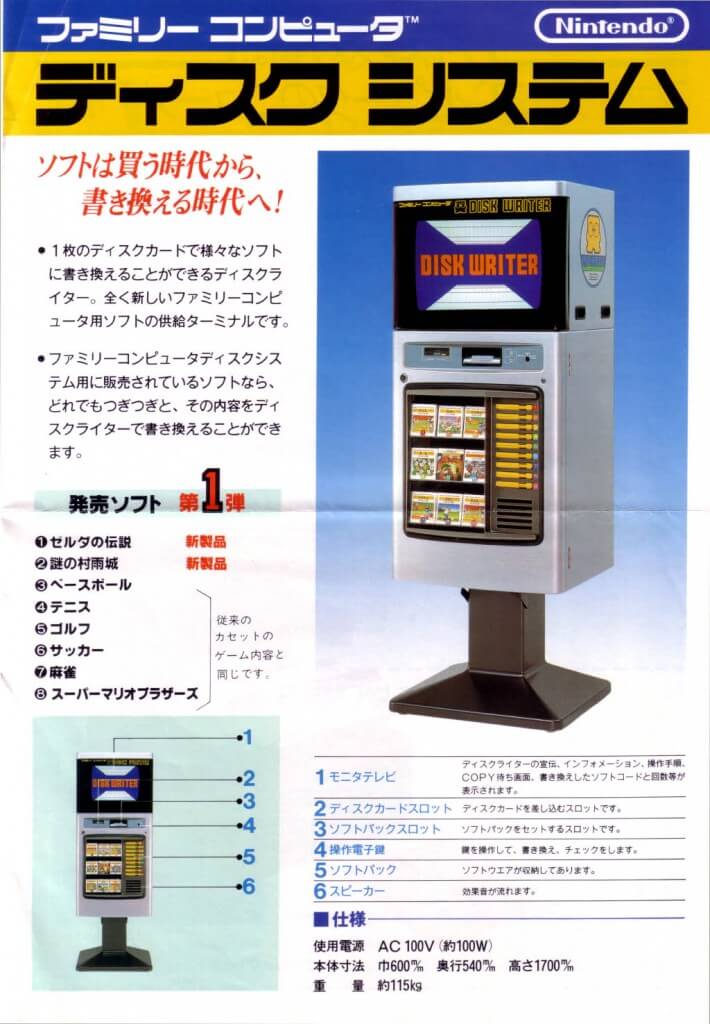
Nintendo offered its users much more than a cheap new disc format of its own, unlike its competitors who used standard discs and were struggling with illegal piracy, Nintendo would turn the tables and offer its users the possibility of recording and rewrite games on their discs, but legally and for a small fee.
Nintendo distributed in Japan more than 3,200 Famicom Disk Writer in its authorized stores, some dispensers in which for 500 yen, we could record different games without any limit, the blank disc costing 2,000 yen. In this way, Nintendo created its own distribution network for its new peripheral, allowing users to enjoy a large number of games at a much cheaper price, a new model far removed from cartridges: now they could choose between keeping the game and expand your collection or replace it for 500 yen. The important thing is that they could choose.
But Nintendo was not satisfied with lowering production costs or creating a new distribution network and business model, to promote the Famicom Disk System Nintendo created the Famicom Disk Fax: A new device placed in kiosks and authorized sales points where , with a specific software, players could share, compete and obtain prizes at a national level based on their own records.
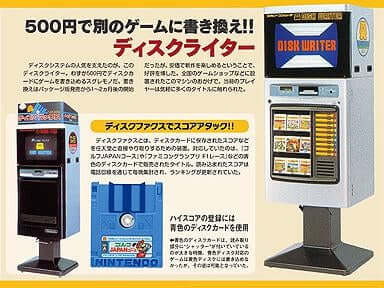
To differentiate the format, the disks chosen for the Famicom Disk Fax were blue in color and slightly modified. Users could acquire them and try to obtain the highest records in the following games in their own homes:
- Golf JAPAN Course
- Golf US Course
- Tokimeki High School de Miho Nakayama
- Famicom Grand Prix F1 Race
- Famicom Grand Prix II 3D Hot Rally
Once some little Japanese boy or office worker had set a certain score, he would save the results along with his name and address in the game and proudly take his disk to the nearest Famicom Disk Fax (kiosks and stores), insert his disk for free and these scores were sent to Nintendo offices (different records could be sent). Once a year Nintendo, Nintendo established and published in the kiosokos and stores the cutting line in the different games, and everyone who passed it received a prize such as a Famicom video game. Pure envy gentlemen!
Twin Famicom and the idyll of Sharp and Nintendo
Sharp, a manufacturer of chipsets and semiconductors, which had wonderful relations with Nintendo in those years, knew how to see the entire universe that Nintendo was creating around its new peripheral and the possibilities that it offered, so it went on to acquire the license of its console and peripherals to the Japanese company Nintendo, something that few companies could boast of given the company policy of Nintendo and its consoles.
Fortunately for Sharp, relations between the two Japanese companies were excellent, coming to be considered partners rather than mere licensees:
- 1977 Sharp Color TV-Game 6 (models CTG-6S and CTG-6V). Sharp obtains the license from Nintendo to manufacture its own Color TV-Game 6, designed to be sold together with its televisions.
- 1977 Sharp Color TV-Game 15 (Model Color TV-Game XG-115). Sharp obtains the license of the Nintendo console with 15 integrated games.
- 1981 Game & Watch. Different Nintendo machines incorporated different versions of the 4-bit CPU from the Sharp SM5xx family.
- 1983 My Computer TV C1 or the Sharp Nintendo Television. The same year the Famicom was released, Sharp made a TV with the Famicom built in and a higher than original picture signal with RF output.
- 1984 Family Basic keyboard developed by Hudson Soft and Sharp for the Famicom.
- 1986 Famicom Station, a 15-cartridge hotel Famicom (and NES) that was played for time.
- 1986 Twin Famicom. Sharp makes the Famicom/Famicom Disk System combo console.
- 1989 Famicom Titler: A few years after the Twin Famicom Sharp would make a Famicom/video title generator with S-Video output. There it is.
As if these relationships were not enough, in 1981 Sharp registered the FAMICOM brand for its line of household appliances, more specifically microwaves. Years later, it would cede the use of the FAMICOM brand to Nintendo in the video game sector, maintaining it today as a registered brand in household appliances. In this context, it is perfectly understandable that Nintendo prioritized revenue from strategic licenses and the consequent increase in software sales, at the expense of minimizing revenue from direct hardware sales, in the early years of manufacturing in which hardware was always it is expensive.
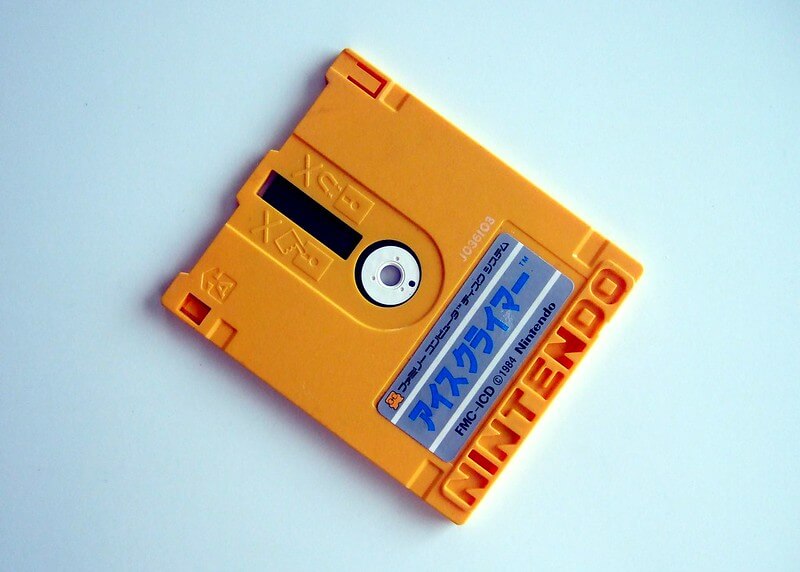
Twin Famicom, Sharp’s console
This time Sharp did not limit itself to selling components or making an exact licensed clone of the Nintendo console as it did in 1977 with the Color TV-Games. The success of the Famicom, and the innovative network and infrastructure it was creating around its flagship Famicom Disk System peripheral, encouraged Sharp to create a differentiated console that included the best of Nintendo, improving upon the advancements of 1986.
In practice, the Twin Famicom is a 100% compatible Famicom that integrates the Famicom Disk System, improving the sound of the original console and the video, since in addition to an RF output it included an AV output (components), ostensibly improving the quality of image in this way, in a time when many Japanese households already had more modern televisions.
The exterior of the Twin Famicom is that of a robust machine, in which the space to store the controls draws your attention, so characteristic of an orderly society and of small houses such as the Japanese, as well as the controls themselves, which have a extremely attractive design with a big “1” and “2” depending on the driver. As in the Famicom, the second controller has a microphone and volume controller, something that was not inherited in the versions that Nintendo exported to the rest of the world with its NES. As a curiosity, in the second and third versions of the Sharp console, both controls included two turbo buttons so typical at that time for the Martians.
Continuing with the exterior, the Twin Famicom has its own Famicom expansion port and another to connect another Famicom Disk System unit, something quite curious and for which I have not found any information for its use, being able to only speculate that Sharp would have considered the possibility of recording or copying content from the Famicom Disk when connecting a second unit…
Regarding its target audience, Sharp had no choice but to focus its console on those users interested in video games who, in 1986 and later, had not yet acquired a Famicom, something really difficult to find in Japan. Being a combo Sharp did not have access to the millions of Nintendo users, also having the handicap of being a really expensive console being a combo, 32,000 yen was 2,200 yen more than the purchase of a Famicom and a FDS separately, focusing its marketing strategy to a more adult audience with more purchasing power.
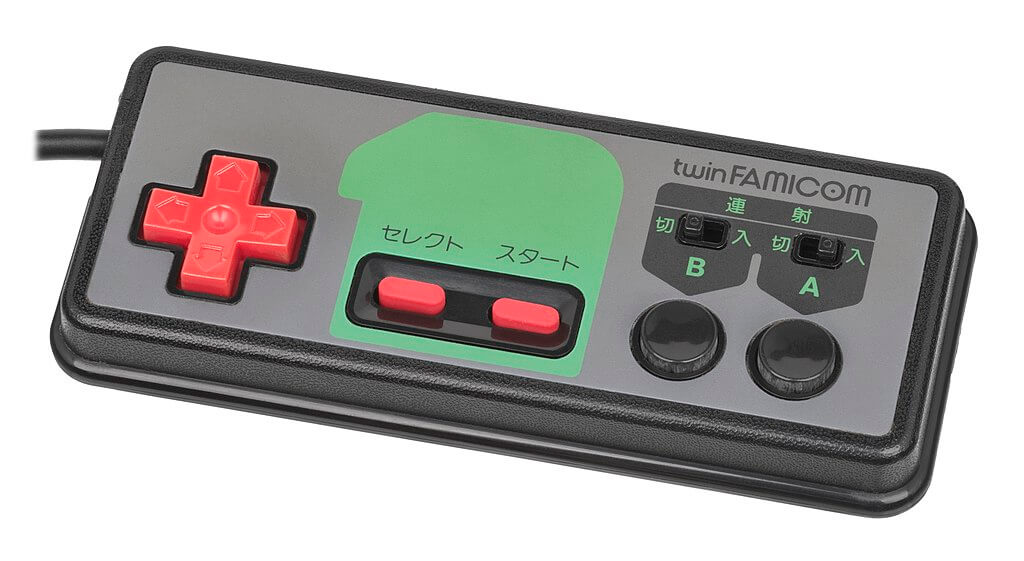
The gaming experience, is it currently playable?
In terms of playability and gaming experience, it is, as you all know, the same as that of the best-selling 8-bit console in history, the Nintendo Famicom. The Twin Famicom has the advantage of having access to its entire catalog of video games on cartridges and discs, yes, exclusively in Japanese (keep that in mind). The Twin Famicom is a console that will not disappoint anyone who knows how to appreciate the golden years of video games in the 80’s, with games that may seem simple or shallow today, but are the seed of everything we enjoy. nowadays.
If, like me, you have been lucky enough to live and enjoy those years, you already know exactly what I am talking about… The gaming experience is nostalgia in motion, your games and memories will look better than ever. For those of you who weren’t that lucky, beware, the beautiful 8-bit pixelated graphics can bring you more than one disappointment if you don’t know how to select well from its immense catalog and even so, it is possible that many of its games seem childish, underdeveloped or infuriatingly difficult. Those were other times and the truth is that few games from those years measure up when compared to current gameplay, for someone who doesn’t have the nostalgia factor.
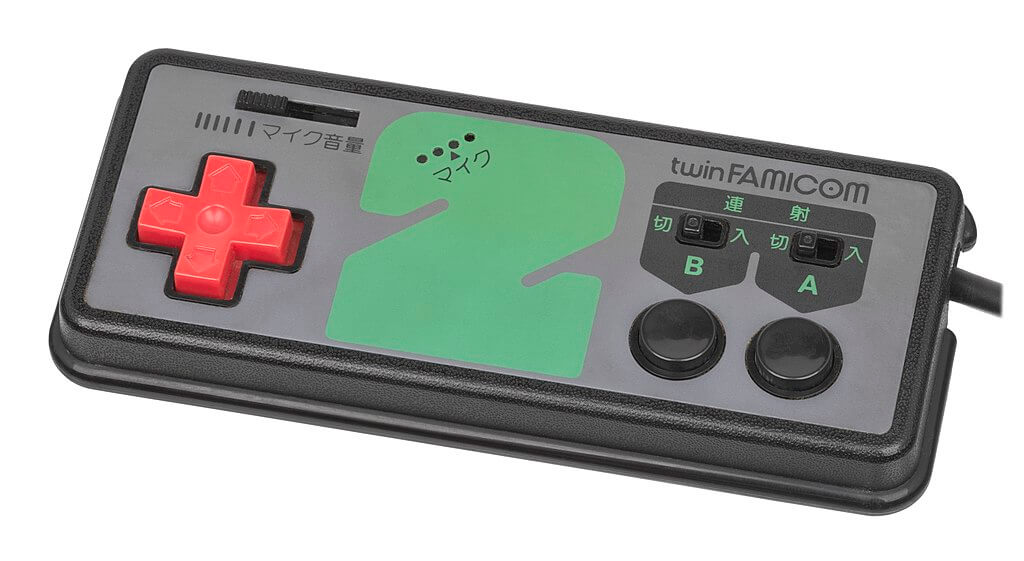
The decline of the Twin Famicom
Obviously, the most important factor and greatest benefit perceived in the Sharp console was that of the Famicom Disk, so the life of the console was closely linked to the good health of the Nintendo peripheral. It is true that the Twin Famicom could run cartridges, but if a user prioritized ROM cartridges, he had the option of buying a much cheaper original Famicom instead of the Twin Famicom combo.
As we have already commented on Infoconsolas, the Famicom Disk System had a remarkable success and numerous advantages, being an ideal format for developers to innovate and launch original products in cartridge format that were not viable due to their high costs, but as the years passed the technology was advancing and the cons to the FDS were added:
- Loading time: The cartridge was the king of immediacy, a sign of the consoles before the computers. On the other hand, the disks required considerable load times both to write and to read.
- Capacity: The same year that the Famicom Disk System and Twin Famicom were launched, the first 1 megabit video game arrived, a capacity greater than the Famicom Disk. In July of the same year, a cartridge with 2 MBit appeared. Semiconductors dropped in price and allowed to produce cartridges with more memory, overcoming one of the main reasons for the existence of the FDS, the capacity, the same that it could not expand with its Famicom Disk.
- Save games: In 1987, the first Famicom cartridge with a lithium battery was sold to save games, much faster than the Famicom Disk.
- Sound enhancement: In 1988 various cartridges incorporated sound chips that enhanced the original sound of the Famicom and its Famicom Disk System.
- Maintenance: The Famicom Disk was weaker than cartridges against dust and moisture, while care had to be taken not to bring it close to magnetic sources that would corrupt the content (data) of the disk.
- PC Engine SUPER CD-ROM 2: In 1988 NEC launched its peripheral CD-ROM for its console in Japan, a breakthrough that left Nintendo and its FDS in a very bad place.
- Sellers complained about the low profit margins generated by the Famicom Disk format and the option to record games for 500 yen compared to the cartridge.
- Nintendo and its absolute monopoly, imposed high license fees to publish games in disc format, causing many developers to reject releasing their games in the new format.
Time played an accelerated trick on Nintendo, the 80’s were frenetic in terms of technological advances and, from just 1 mega disk in 1986, the video game industry had gone to CD-ROM in 1988 and much cheaper cartridges and with support chips for better games. The Famicom Disk System was present for many years, but its initial impact faded in just 1 year, so the Twin Famicom was also affected by the advances exposed above, but in a double way:
Hardware licenses are sometimes a poisoned gift. As happened with Goldstar and its 3DO, Sharp did not develop video games and obtained benefits only from the hardware sold and not from the software as Nintendo did, consequently Nintendo had the possibility of lowering the price of its console, with the guarantee of later obtaining income. through their games and their licenses. This strategy made things difficult for Sharp, which, in order to lower the price of the console as the years passed, had no other option than to lower manufacturing costs.
As history has shown, the successful model is one in which the manufacturer holds a hardware monopoly, licensing the sale of software, a situation far removed from that of Sharp, leaving the company extremely exposed to the good image and actions of Nintendo on its Famicom and Famicom Disk System, such as the little room for maneuver that Sharp had before the sales of the Nintendo machine. Even so, Sharp managed to sell more than 1 million video game consoles in a market already saturated by Nintendo, proving that its proposal was successful in form, but late in time.
The price of the Twin Famicom console
Below you have a list with the prices of the Twin Famicom and its contemporary consoles at the time of its release. We trust that in this way you will be aware not only of how much a Twin Famicom cost, but of what it meant to acquire the Sharp console compared to other retro video game consoles.
| CONSOLE | LAUNCH | PRICE | COMPANY |
| Famicom | 1983 | 14.800 yenes | Nintendo |
| SG-1000 | 1983 | 15.000 yenes | SEGA |
| Sega Mark III | 1985 | 15.000 yenes | SEGA |
| Famicom Disk System | 1986 | 15.000 yenes | Nintendo |
| Twin Famicom | 1986 | 32.000 yenes | SHARP |
| PC Engine | 1987 | 24.800 yenes | NEC |
| X1 Twin | 1987 | 99.800 yenes | NEC |
| Mega Drive | 1988 | 21.000 yenes | SEGA |
| PC-Engine Shuttle | 1989 | 18.800 yenes | NEC |
| PC Engine Core Grafx I | 1989 | 24.800 yenes | NEC |
| PC Engine Super Grafx | 1989 | 39.800 yenes | NEC |
| Super Famicom | 1990 | 25.000 yenes | Nintendo |
| Neo Geo AES | 1990 | 58,000 yenes | SNK |
| PC Engine GT | 1990 | 44.800 yenes | NEC |
| PC Engine Core Grafx II | 1991 | 19,800 yenes | NEC |
| PC Engine Duo | 1991 | 59.800 yenes | NEC |
| PC Engine LT | 1991 | 99.800 yenes | NEC |
It really wasn’t easy to decide to buy a Twin Famicom, not only because you could buy the original console and peripherals independently, turning out to be cheaper, but also because just a year after its launch, the lavish PC Engine hit the Japanese market from NEC, a super console that was far beyond the capabilities of the Famicom or Twin Famicom, at a much cheaper price. In the same way, in 1988 Sega’s MegaDrive appeared, a super 16-bit that was misunderstood in Japan.
Collecting the Twin Famicom
The Twin Famicom is a console purely for collectors, an 8-bit console exclusive to Japan with an interesting story behind it, a rarity based on a peripheral that never left Japan, which also has interesting advantages over the original Famicom. All this makes the Twin Famicom one of the most coveted retro consoles among video game console collectors.
When it comes to collecting the Twin Famicom is when we find ourselves before the abyss as console collectors: More than 1000 games on cartridges, almost 200 games on discs with the impossibility of recording them for most mortals, games very localized in Japan with the language barrier… Where to start?
As we usually recommend in Infoconsolas in the face of challenges of this type, let’s forget about the full set for rich people and focus on enjoying our hobby: Any of the three editions of Twin Famicom will give us a good result, so at first we have to make a list of updated prices on eBay of Twin Famicom and of the games that we want and/or most representative, once we know what our objectives are and what we are willing to pay for each one, we will be ready to, without haste, start our quest for retro
As we always say at Infoconsolas, one of the best pleasures of collecting retro consoles and video games is the search, so… Patience and good hunting!
Buy a Twin Famicom
Where to buy a Twin Famicom? Here at the link below you will find a list of Twin Famicom consoles with updated eBay prices. For consoles like these, eBay is the best sales platform according to our own experience as collectors, a console like an 8-bit retro that never left Japan, will not magically appear in the second-hand store in our neighborhood or trace of our city.
As you may have seen, the Twin Famicom is not a cheap console if we are only going to use it as a Famicom, its value lies in being a collector’s item of which only 1 million units were manufactured, the Twin Famicom is a rare commodity. Is it worth buying the Twin Famicom? This is a key question, if one is a collector the answer is a clear and resounding yes, but if our intention is to play or discover this system, be clear that you must be able to appreciate and value the games of an era that is already far behind , either for nostalgic value or because you are really passionate about retro and video game culture.
If, in addition to considering this console as a museum piece, you are able to enjoy its titles decades after its launch and in the midst of the teraflops and 8K era, a whole world of timeless classics that drink from the The very origins of video games, a few years in which video game genres were still being invented, mechanics were not yet established and great titles became sagas that have survived to our time. After all, we are talking about the Famicom catalog, living history of video games.
STOP COLLECTOR! If you’ve seen the console listing on eBay, I want to say THANK YOU. Since 2004, the objective of Infoconsolas is to contribute to preserving the history of consoles and video games through our own collection of systems and the hours of work invested in this very website.
Being an eBay partner listing, if you buy a game or console, you will be helping Infoconsolas in the preservation of video game culture, so thank you very much again!
TOP: Best Twin Famicom Console Games
As the Twin Famicom is a console compatible with the Japanese Famicom and its Famicom Disk System, on this occasion I have chosen a video from the MetalJesusRocks channel in which, in addition to giving us good purchase advice, they show us a good selection of games that can be played by an audience western.
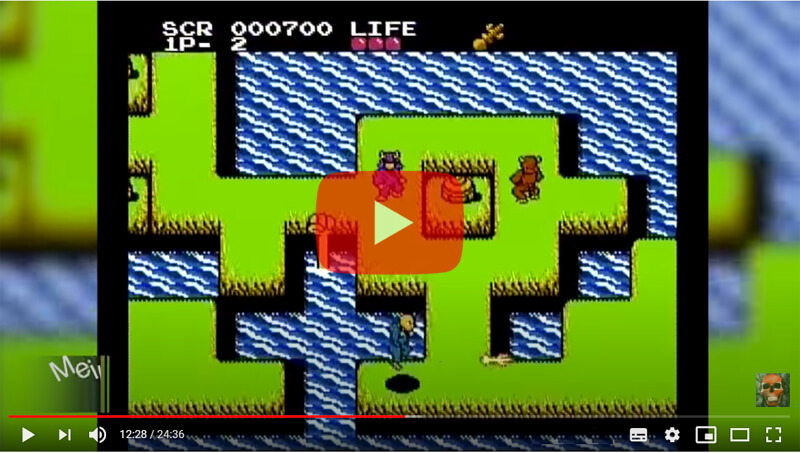
As you have seen, the Famicom and Twin Famicom disc format offered developers a cheaper alternative for their releases, making it possible to make more risky and creative proposals, as well as versions and continuations of certain sagas.
FAQ Twin Famicom
Here you have the most frequent curiosities, questions and answers about Sharp’s Twin Famicom retro console, little by little we will expand this section:
July 1, 1986 in Japan.
Approximately 1 million units.
32,000 yen
The Famicom 14,800 yen and the FDD 15,000.
1,053 compatible cartridges (Japanese).
198 commercial discs plus 4 official ones not for sale.
Takahashi Meijin no Bōken Jima IV, on June 24, 1994 in Japan, from Hudson Soft.
The Legend of Zelda.
じゃんけんディスク城, which we could translate as: Rock Disc Castle, Paper Scissors.
It does not have voice recognition but it does differentiate the volume of the sound input, being used in some games to, for example, hit more or less hard.
Yes, in the back, they cannot be disconnected.
Yes, depending on the game. it was usually done on the B side.
Yes.
Yes, on the Disk Writer machines that Nintendo distributed throughout Japan.
2.000 yen.
500 yen, regardless of the game.
Until September 30, 2003.
896 kilobits (112 kilobytes), 64 kilobytes on each side. It did not reach what we know as 1 mega.
Input: 100VAC 50-60Hz
Output: 7.6VDC 1250mA (1.25A)
Polarity: Centre Pin Positive
(-)————(o————(+)
Barrel Size: Outer Diameter 5.5mm; Inner Diameter 2.5mm
Technical characteristics of the Sharp Twin Fam
Being a combo of the Famicom Disk System with the Famicom, here are the features of both systems with the relevant modification of the video output:
FAMICOM (with AV output):
- CPU: Ricoh-manufactured 8-bit processor based on MOS Technology6502 at 1.79 MHz, with 4 tone generators (two squares, one triangle, one noise), one DAC device, and Restricted DMA Controller.
- RAM: 2 KB, with the option to use an expansion if it was present on the cartridge.
- PPU: Ricoh video processor at 5.37 MHz in its NTSC version.
- Palette: 48 colors and five grays in the base palette.
- Screen colors: 52 colors.
- Sprites on screen: 64 (without reloading in the middle of the screen).
- Sprite sizes: 8×8 or 8×16 pixels.
- Video memory: PPU connected to 32 KB of video RAM. PPU contains 2 KB internal frame/attributable RAM; 256 bytes of sprite position RAM; 28 bytes of palette RAM (allowing background color selection); 8 KB of frame pattern ROM/RAM on the cartridge.
- Resolution: 256×240 pixels.
- Connectors: Ports for controllers: 2, 60 pin game cartridge slot, extension bay, AV out, DC current input.
FAMICOM DISK SYSTEM:
- Disk system main unit (HVC-022).
- 6 Type C batteries or current.
- RAM adapter (HVC-023).
- Onboard RAM is 256 kilobits for program data and 64 kilobits for sprites and backgrounds.
- Improvement in the sound of the Famicom.
External sources and links
- Technical characteristics extracted from Wikipedia
- Graphic resources:
- https://thedoteaters.com/
- https://www.flickr.com/photos/bochalla/6538065139/in/photostream/
- https://commons.wikimedia.org/wiki/User:Evan-Amos
- http://blog.beforemario.com/2011/04/nintendo-color-tv-game-6-6-1977.html

